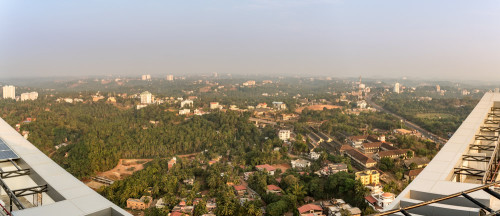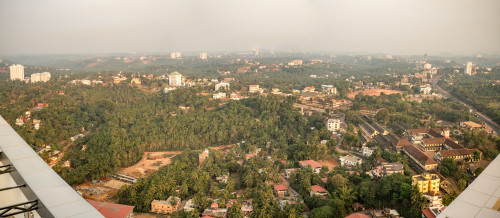
Few days back I purchased a Metabones Canon EF to Sony E-Mount T Smart Adapter Mark IV to test Sony Alfa cameras with Canon EF lenses. This adapter allows you to use your Canon mount lenses on Sony E-Mount camera. I had recently attended Sony workshop and was impressed by their cameras. I wanted to test the camera as well as the compatibility of their camera with my collection of lenses as Sony still lack several crucial lenses especially fast lenses. As I did not own any Sony camera, I asked my good friends to provide theirs for testing this adapter. I ran the test on both Sony Alpha a6000 and on Sony a7RII. Since this test involved compatibility and speed of focus I am not delving into detailed review of any of these Sony cameras. There are several web sites who has reviewd these cameras in detail, so this brief note will only stick to the goal of testing the adapter.

Metabones has created a solid piece of fully metallic chromed brass mounts and perfect fit. Each mount is held by six screws and there’s even a removable, metal tripod foot on the adapter itself. Metabones calls it Smart adapter. “Smart Adapters” retain electronic communication between the camera and lens to provide automatic aperture control, EXIF data, image stabilization and autofocus. The adapter is powered by the camera body, so no external power source is required. The Mark IV provides the same functions as the Mark III but provides optimized performance and an improved internal structure.
The Smart Adapter IV offers two distinct operation modes: Green and Advanced modes. Each mode supports a different set of features and is selected when you mount the lens. Green mode is the default mode and it is designed to conserve battery power by limiting aperture diaphragm movements and image stabilization. Around the barrel there’s a button for selecting green or advanced modes. These modes are selected before you mount the lens: with the camera on, hold the button before mounting the lens to activate the “advanced mode”. With a standard mounting (camera off), the Metabones adapter works is green mode. It bypass the Sony E-mount “always-on” aperture control during Live View, like native FE lenses, and theoretically saves battery power. On “advanced” mode the Metabones adapter makes your Canon lens behave like Sony FEs. The aperture will be adjusting itself all the time during Program AE (DOF Preview) and the manual focus magnification works automatically. Best is to leave it on green mode and don’t bother about “advanced” mode.

Every time you turn the camera ON for the first time, the first two autofocus attempts are used to calibrate the lens and as a result may not lock successfully on the target. Half-press the shutter release button again and autofocus will lock successfully. So forget about using it every first tries it’s going to miss after the camera boots.
Only Canon-branded lenses introduced in or after 2006 are officially supported. This Smart Adapter is also compatible with fully manual lenses which have no electrical contacts. For a list of reported compatibility with specific lenses please see the Metabones website.

As soon as I got the two Sony Camera bodies, I tested them with their native lenses first before embarking on to the ef lenses. My adapter came with firmware 0.41, as their website had a new firmware, I upgraded it to Firmware 0.47, before testing it. Remember the adapter does not come with a manual. Please download pdf file from here.
Here are the four lenses I tried with both cameras. There was also Zeiss Batis 25mm f/2 native lens which is a gem of a lens and is an extremely sharp lens.
- Canon EF 16-35mm f/4L IS USM Lens
- Canon EF 24-70mm f/4L IS USM Lens
- Canon EF 100mm f/2.8L IS II USM
- Canon EF 70-200mm f/2.8L IS II USM

I got to test Sony Alpha a6000 first, as it arrived earlier. My aim was mainly to check the way it focuses. As Sony a6000 has 179-point Phase detection AF points and 25-point Contrast detection AF points, I was expecting fairly good amount of focus speed. All the 4 lenses on a6000 failed miserably when used with Metabones adapter. It was able to do only contrast-detect AF with these EF mount lens, which is disappointingly slow and inadequate for all but statues. Continuous AF and Eye AF is not supported along with DMF mode (direct manual focus) which is also not supported. Overall it is unsuable for any decent focusing on this body except manual focus. So I did not do any more extensive test on A6000.

Next camera I tested was Sony a7R II. This is a pretty impressive camera very similar in characteristics to my Canon EOS 5DS R megapixel monster. The 42 megapixels full frame camera feels solid but tiny in my hands. It has has 399-point Phase detection AF points and 25-point Contrast detection AF points. Here is where the Metabones adapter really shines. Fast phase-detect AF was working just like native lens. The AF points near the center always work well, but those on the edges and in the corners were slower. On tele focal length (200mm of 70-200mm lens) they were slower in latching the focus as compared to the wider focal length.
The contrast AF was just like A6000 and was pretty slow and erratic. Sony a7RII supports only contrast-detect AF during video recording. Video AF speed was unsatisfactory and not as good as that for stills. Even though I did not test extensively, during movie capture, auto focus needs to be manually activated by half-pressing the shutter release button if subject moves to a different distance. Continuous AF was working, but was not as good as the phase-detect AF of a7RII. Eye AF and DMF mode (direct manual focus) were not supported just like Sony a6000.

Let us see the features of this adapter. Here is what Metabones claims about the adapter. I checked all these claims and each one of them works as mentioned.
- Phase-detect autofocus support on A7RII.
- Supports 5-axis in-body image stabilization of A7RII.
- Powered by camera body. No external power source required.
- Aperture control from camera body.
- Wide open button (opposite of depth-of-field preview function) makes manual focusing easy and assignable to a custom function on A7 series.
- Supports image stabilization (IS) lenses.
- Supports electronic manual focusing (e.g. EF 85/1.2L II and discontinued EF 50/1.0L)
- EXIF support (focal length, aperture, zoom range)
- Auto magnify (lens with distance information support required)
- Flocking material coated inside the opening to reduce internal reflection.

Optically canon lenses performed well in the center. Performance at the periphery was not up to the mark especially in Wide angle captures. Overall sharpness as well as clarity is satisfactory. Sony native lenses fared far better than the canon lenses on Sony body.
After testing the adapter on both these cameras, I view this adapter simply as a way to use Canon glass on Sony bodies in manual focus mode. Any autofocus functionality you get is just a bonus. The major benefit is getting to use your collection of Canon lenses on Sony cameras. If autofocus is critical, and you want to have all the features as well optical perfection, I’d just recommend using native E-Mount glass. Since my major work involves macro and wildlife, Sony is still not up to the mark for my needs. I hope the type of innovation Sony is doing continues and soon we will get a good enough camera to replace both Nikon & Canon DSLRs. Until then I will be still holding on to DSLR as I feel if it ain’t broke, don’t fix it .

Disclosure: I was not financially compensated for this post. I purchased a Metabones adapter using my own money for this review. Sony camera bodies were loaned to me by my friends for review purpose. The opinions are completely my own based on my experience. I am very extremely thankful for Abhijit M & Prasad Kini for providing their “bodies” for this test 😉


Thanks so much for the concise, but useful review Dr. Krishi.
Thank you for this. I experience the same issues with canon lenses, metabones iv with both my A7s and A7R2 and really hope that future firmware upgrades from metabones will improve this.
I have spoken to metabones. They said, these are drawbacks of the respective cameras and their firmware. So unless Sony updates the firmwares (which seems unlikely) there may not be any improvement in A7s and A7R2. 🙁